welcome to worldwidewachs.com
Un Poco Mas
Cochabamba, Bolivia October 12 – 27, 2001
October 12 – 14, 2001
We’re on a Loyd Aero Boliviano flight from Sao
Paulo, Brazil to Cochabamba, Bolivia, buzzing from a glorious week in Sao
Paulo with Luciana (our exchange student from 5 years ago, now a law student
in Sao Paulo), Luis (her boyfriend, also a law student) and various members
of Luci’s wonderful family.
A few days ago, during a Sunday afternoon family
get-together in Sao Paulo, we first learned about the U. S. bombing of
Afghanistan. The announcement was a brief, but solemn interruption to
the intense, emotional rivalry of the Brazil – Argentina soccer game, and
took a clear second place to Brazil’s impending win. I asked Luci’s
family if Brazilians would be angry about American retaliation, if perhaps
we should be more careful about walking the streets of Sao Paulo. They
assured me that although 75% of Brazilians do not agree with the American
retaliation, they expected this response and would not hold hard feelings
toward individual Americans.
The news of the bombings is still fresh, raw, scary and sickening.I’ll ask many South Americans over the next few weeks whether they agree with the U. S. actions.Giving various reasons, almost none of them do.
But now it is dark and we are swooping into the valley of Cochabamba early at night, a blanket of twinkling lights, like a parade of Christmas candles below us, ready to cushion our landing.The customs officials seem bored with our luggage, waving us through without a glance.And suddenly we are met by Jean Carla, the young, vivacious director of the Amizade program, and Diego, her delightful cousin.They greet us enthusiastically and guide us through the airport, then drive us through the lively city to our lodging for the night.
The Hostal Jardin is barely noticeable from the busy, narrow street, but behind the lobby and the gate, it opens into an extensive patio and garden, lined with colorful flowers and white, wrought-iron furniture.The rooms are basic but clean, with narrow tiled bathrooms.As you enter the bathroom you’re at the sink, then to reach the toilet you walk through the shower area (no walls or curtains separating them).A shower will clearly clean not only the showeree, but the toilet seat and anything else in the near vicinity.
On our double bed is a miniature version of sheets – they are not wide enough or long enough to tuck in.Tight-fitting sheets being a personal neurotic necessity of mine, I blithely tuck in the bottom and my side, leaving wide chunks of mattress showing at the head and Marvin’s side.I don’t really care whether Marvin objects (he wisely doesn’t) – this is the way it will be.
But the Hostal Jardin staff is eager to please and helpful.The garden and
grounds are a relaxing haven in the center of a bustling city.Breakfast in the Hostal is rolls, coffee or tea.For the first 2 days we explore
 the streets of this city of 750,000, nestled in a broad, sprawling valley – at
8400 feet, still dwarfed on all sides by magnificent angular mountains.The days are warm with the energy and feel of spring.We stroll to the plaza
principal in the hectic downtown business section, and through the shaded
hilly residential areas. We walk the lush tropical gardens of the Palacio
Portales, exquisite and vibrant with flowers of vivid oranges, sultry reds
and screaming yellows.We wander shaded stone pathways leading to the huge mansion, now a cultural and arts center.
the streets of this city of 750,000, nestled in a broad, sprawling valley – at
8400 feet, still dwarfed on all sides by magnificent angular mountains.The days are warm with the energy and feel of spring.We stroll to the plaza
principal in the hectic downtown business section, and through the shaded
hilly residential areas. We walk the lush tropical gardens of the Palacio
Portales, exquisite and vibrant with flowers of vivid oranges, sultry reds
and screaming yellows.We wander shaded stone pathways leading to the huge mansion, now a cultural and arts center.
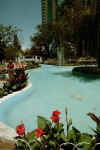 In the residential areas surrounding the palacio the sun glistens on the meandering bougainvillea, draped casually over sherbet
shades of stucco walls. It prances gracefully through the swaying jacaranda trees, bursting with tangy violet blossoms.
In the residential areas surrounding the palacio the sun glistens on the meandering bougainvillea, draped casually over sherbet
shades of stucco walls. It prances gracefully through the swaying jacaranda trees, bursting with tangy violet blossoms.
The tree-lined Prado is alive with Cochabambinos, visiting, strolling, engrossed in conversations at outdoor cafes while sipping on refrescos.The city is a delightful mixture of old and new, beauty and fading beauty, wealth and poverty.There are stark modern glass high rises within view of homeless peasants living under the bridge, hungry children wandering in carefully tended, garden-filled plazas, 16th century crumbling churches bearing 21st century graffiti.But it is a proud and beautiful city, teeming with life.
October 15 – 18, 2001
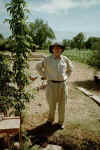 Late
the second afternoon, Jean Carla and Diego and another of her cousins, Ernesto (Diego’s younger brother) transport us to Vinto, a small town outside
Cochabamba, where we will stay during the next week.Our other volunteer, a wonderful guy named Jim, whom we
already knew from our Nicaragua trip, flew in last night and has joined our group too.The three of us form the
smallest group of volunteers Amizade has ever had, but we give Jean Carla bold (however bluffing) assurances that we’ll work so hard and accomplish
so much she’ll think there were ten of us.We’re bursting with eagerness, and Jean Carla’s goal of constructing 3 outside walls
of an orphanage sounds daunting, but challenging.
Late
the second afternoon, Jean Carla and Diego and another of her cousins, Ernesto (Diego’s younger brother) transport us to Vinto, a small town outside
Cochabamba, where we will stay during the next week.Our other volunteer, a wonderful guy named Jim, whom we
already knew from our Nicaragua trip, flew in last night and has joined our group too.The three of us form the
smallest group of volunteers Amizade has ever had, but we give Jean Carla bold (however bluffing) assurances that we’ll work so hard and accomplish
so much she’ll think there were ten of us.We’re bursting with eagerness, and Jean Carla’s goal of constructing 3 outside walls
of an orphanage sounds daunting, but challenging.
Our home in Vinto for the “work week” is Casa de Retiros, (Spanish for “retreat center”) that looks like a
 huge, spread out motel.The outside is cream stucco, trimmed in dark brown wood. Lining the paths to the rooms are
rose bushes in well-tended lawns.Our room has a tiled floor, with 2 narrow twin beds, and thin mattresses with no
boxsprings.We have a bathroom with a toilet and shower, including hot water.There’s
a huge dining area across the patio where we’ll eat all our meals.Although not fancy, it is quite comfortable - unexpected luxury compared
to accommodations in other work trips - and we’re feeling pretty darn lucky.
huge, spread out motel.The outside is cream stucco, trimmed in dark brown wood. Lining the paths to the rooms are
rose bushes in well-tended lawns.Our room has a tiled floor, with 2 narrow twin beds, and thin mattresses with no
boxsprings.We have a bathroom with a toilet and shower, including hot water.There’s
a huge dining area across the patio where we’ll eat all our meals.Although not fancy, it is quite comfortable - unexpected luxury compared
to accommodations in other work trips - and we’re feeling pretty darn lucky.
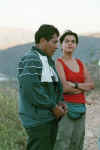 For the next four days, we’re on a busy work schedule.Up at 6:30, breakfast (bread, watered-down juice of unknown
fruitlike origins, and coffee) in the large, tiled Casa de Retiros dining room, a short ride aboard our personal trufi
(Bolivia’s most common means of public transport in the form of a 15-passenger van), and off to work at the orphanage (Hogar de Ninos).
Our trufi driver is a wonderful guy named Raul, who will take us everywhere over the next several weeks.
For the next four days, we’re on a busy work schedule.Up at 6:30, breakfast (bread, watered-down juice of unknown
fruitlike origins, and coffee) in the large, tiled Casa de Retiros dining room, a short ride aboard our personal trufi
(Bolivia’s most common means of public transport in the form of a 15-passenger van), and off to work at the orphanage (Hogar de Ninos).
Our trufi driver is a wonderful guy named Raul, who will take us everywhere over the next several weeks.
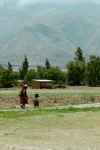 The Hogar is quietly hidden several miles out in the country, down a dusty dirt road, across a deep culvert, and past
several small corn and alfalfa farms.It is currently one completed and one under-construction building on several acres,
the site dwarfed by the surrounding, snow-capped mountains, a simple haven in the cradle of majesty. Thirty-six children, ages 1 – 12, live here.
They are cared for by 3 nuns who must work constantly to take care of their needs – preparing and feeding them, washing their clothes, seeing that
the older ones get to school, providing medical attention when needed.
The Hogar is quietly hidden several miles out in the country, down a dusty dirt road, across a deep culvert, and past
several small corn and alfalfa farms.It is currently one completed and one under-construction building on several acres,
the site dwarfed by the surrounding, snow-capped mountains, a simple haven in the cradle of majesty. Thirty-six children, ages 1 – 12, live here.
They are cared for by 3 nuns who must work constantly to take care of their needs – preparing and feeding them, washing their clothes, seeing that
the older ones get to school, providing medical attention when needed.
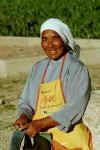 They’ve only had these buildings for a little more than a year.Five years ago, one of the nuns (Sister Leticia) and a smaller group of
children lived under corrugated tin shelters leaned against each other for support.Before that, they wandered
the streets of the nearby town of Quillacollo, begging for food and shelter.A benefactor gave Sister Leticia this land just a few years ago so the
children would finally have a place of their own.
They’ve only had these buildings for a little more than a year.Five years ago, one of the nuns (Sister Leticia) and a smaller group of
children lived under corrugated tin shelters leaned against each other for support.Before that, they wandered
the streets of the nearby town of Quillacollo, begging for food and shelter.A benefactor gave Sister Leticia this land just a few years ago so the
children would finally have a place of their own.
Last year Amizade, the organization sponsoring this trip, undertook the building of permanent housing for
 the kids, and today there is one new red brick building.It is simple, but clean and new and bright with hope.It has a spacious, tiled study/play area,
two bathrooms, and two dorm rooms – one each for girls and boys.Each dorm room has rows of narrow cots down each side of the long walls, the cots
covered with various brightly colored donated quilts. There are not quite enough cots, so some children must sleep together.There are no dressers,
mirrors, closets, bedside tables – nothing.These children have no possessions.
the kids, and today there is one new red brick building.It is simple, but clean and new and bright with hope.It has a spacious, tiled study/play area,
two bathrooms, and two dorm rooms – one each for girls and boys.Each dorm room has rows of narrow cots down each side of the long walls, the cots
covered with various brightly colored donated quilts. There are not quite enough cots, so some children must sleep together.There are no dressers,
mirrors, closets, bedside tables – nothing.These children have no possessions.
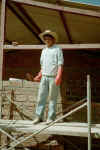 Our workdays are from 8:15 to noon, back to the Casa de Retiros for lunch and siesta, then back to work from 2:30 to 5:00.Felix, the maestro
(head mason) is our building supervisor, coach and teacher.He’s Quechuan – small, dark, quick to smile, and patient with his norteamericano
students.He shows us how to blend just the right amount of water with the cement to create the perfect mezcla,
pile the mezcla on the wall and ease the bricks expertly to the optimum position, how to scoop up the mezcla
droppings with a trowel and slide the mezcla into the waiting spaces, how to move the measuring string to the next position,
and how to use the plomada to be sure the wall is rising straight.“Un poco mas” (a little more) is his favorite expression.
He uses it encouragingly, assuring us we have it almost right, but that with just “un poco mas”, it will be perfect.
Our workdays are from 8:15 to noon, back to the Casa de Retiros for lunch and siesta, then back to work from 2:30 to 5:00.Felix, the maestro
(head mason) is our building supervisor, coach and teacher.He’s Quechuan – small, dark, quick to smile, and patient with his norteamericano
students.He shows us how to blend just the right amount of water with the cement to create the perfect mezcla,
pile the mezcla on the wall and ease the bricks expertly to the optimum position, how to scoop up the mezcla
droppings with a trowel and slide the mezcla into the waiting spaces, how to move the measuring string to the next position,
and how to use the plomada to be sure the wall is rising straight.“Un poco mas” (a little more) is his favorite expression.
He uses it encouragingly, assuring us we have it almost right, but that with just “un poco mas”, it will be perfect.
 Moises, his helper, is a whirlwind of energy, darting here and there to load more brick,
mix more cement, find missing tools, rig scaffolding.Moises was one of the orphans raised by Sister Leticia, and is dedicated
to improving the lives of these kids and the nuns who raised him.The first few days he takes Marvin under his wing, calling him here and
there to help with various jobs.Moises speaks no English and Marvin no Spanish, but the language of construction is
enough for them.And so the days, punctuated with cries of “Marve-e-e-n” and “un poco mas” stream by, and the walls grow slowly toward the ceiling
(or the ceiling to be).
Moises, his helper, is a whirlwind of energy, darting here and there to load more brick,
mix more cement, find missing tools, rig scaffolding.Moises was one of the orphans raised by Sister Leticia, and is dedicated
to improving the lives of these kids and the nuns who raised him.The first few days he takes Marvin under his wing, calling him here and
there to help with various jobs.Moises speaks no English and Marvin no Spanish, but the language of construction is
enough for them.And so the days, punctuated with cries of “Marve-e-e-n” and “un poco mas” stream by, and the walls grow slowly toward the ceiling
(or the ceiling to be).

 The first day we saw down half the corrugated walls and build concrete forms for the wall bases.Days 2-4 we are heavily
into masonry – building what will become the 3 walls of the kitchen.When the trufi comes to get us
at 5:00 each day, we’re tired and dirty, but feeling pretty good.
The first day we saw down half the corrugated walls and build concrete forms for the wall bases.Days 2-4 we are heavily
into masonry – building what will become the 3 walls of the kitchen.When the trufi comes to get us
at 5:00 each day, we’re tired and dirty, but feeling pretty good.
The kids at the Hogar mostly stay out of our way, although they hang around shyly when we first arrive, their eyes curious, but their bodies still and waiting.There’s no swarming around, or jumping up and down, or joyous greetings.During the morning, the older children are at school, so it’s just the little ones, who play out in the field, or in the study/playroom. There are 5-year-olds caring for 2 year-olds, 3-year-olds wandering freely – the nuns are too busy cooking, washing clothes and doing various chores.But these children are extremely well behaved, and I am never aware they get into trouble.
During the afternoons, sometimes the older boys (9 – 12 year olds) drift over to the construction area,
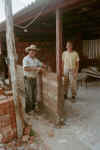 eager to help.They hand us bricks, scoop up stray mezcla, bring water.Small, silent Rodrigo, about 10 years old, works with me for several
hours one afternoon.I smile at him, ask him questions about himself, even try to kid him a little, but he
doesn’t break his silence.He’s a good worker, quick to anticipate what I’ll need next, and diligent about his work.
eager to help.They hand us bricks, scoop up stray mezcla, bring water.Small, silent Rodrigo, about 10 years old, works with me for several
hours one afternoon.I smile at him, ask him questions about himself, even try to kid him a little, but he
doesn’t break his silence.He’s a good worker, quick to anticipate what I’ll need next, and diligent about his work.
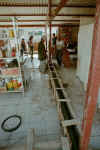 Jean Carla says maybe Rodrigo doesn’t answer my question about his age because he’s afraid.The Hogar can only keep these children until they
are 12 years old.At that time, if they can’t find a place in a home for older children, or a job, or a boarding school, the children are out on their own.
I think about leaving my own daughters to fend for themselves at age 12 – to find their own place to live and a way to provide food and clothing –
and my heart fills with a sick mixture of sadness and fear.Jean Carla says they are trying to develop ways to help the older ones,
but there is realistically only so much they can do at a time.I can see what wonderful strides have been made in such a short time, but
my heart still aches for them.
Jean Carla says maybe Rodrigo doesn’t answer my question about his age because he’s afraid.The Hogar can only keep these children until they
are 12 years old.At that time, if they can’t find a place in a home for older children, or a job, or a boarding school, the children are out on their own.
I think about leaving my own daughters to fend for themselves at age 12 – to find their own place to live and a way to provide food and clothing –
and my heart fills with a sick mixture of sadness and fear.Jean Carla says they are trying to develop ways to help the older ones,
but there is realistically only so much they can do at a time.I can see what wonderful strides have been made in such a short time, but
my heart still aches for them.
Some afternoons, we are joined at work by Diego, his girlfriend Lesa, and Ernesto.They know a little English and Jim and I know some Spanish, so with Jean Carla’s help we communicate just fine.They are fun to be with and good workers, so the afternoons whiz by and the walls slowly grow higher.
One afternoon we leave work just a bit early to visit the shrine of the Virgin de Urqupina in nearby Quillacollo. The shrine is set on a long, sloping hill, facing the mountains (although, in fairness, almost everything here faces the mountains).There is a gentle climb along a wide gravel walkway up to the shrine, behind it a pastoral, flower-filled scene of the Virgin, the shepherd girl who discovered her, and the girl’s flock of sheep.This is the site of a 3-day festival every year, when people from all over Bolivia come to pray for what they want over the next year – money, cars, houses, babies, education – anything.At the vendor stalls at the base of the mountain, you can buy miniature replicas of the items you intend to pray for.
 By the end of the first week, the outside walls of the new kitchen are halfway up,
and the interior wall is almost finished.We start to remove the outside fiberglass walls of the section that will become the
pantry and office areas, and pour the cement footers of the walls.Taking each day separately, it’s hard to notice the progress, but if
you can remember back to the first day, you can see we’ve made great strides.And Jean Carla is jubilant about our work, telling us we’re a bit ahead
of schedule, and are indeed accomplishing the work of more than the 3 of us.
By the end of the first week, the outside walls of the new kitchen are halfway up,
and the interior wall is almost finished.We start to remove the outside fiberglass walls of the section that will become the
pantry and office areas, and pour the cement footers of the walls.Taking each day separately, it’s hard to notice the progress, but if
you can remember back to the first day, you can see we’ve made great strides.And Jean Carla is jubilant about our work, telling us we’re a bit ahead
of schedule, and are indeed accomplishing the work of more than the 3 of us.
October 19 – 21, 2001
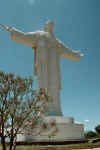
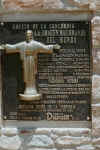

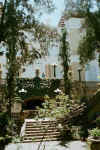 Our reward is a long weekend.On Friday morning we ride the trufi back to the Hostal Jardin in Cochabamba, dump our suitcases, and run a
few errands, then head for the statue of Cristo de la Concordia, at 131 feet, the largest statue of Christ in the world.It is gleaming white,
with outstretched arms, perched on a hill high above the city and visible from almost anywhere.We ride the cable car to the top and drink in 360 degree
views of the city.
Our reward is a long weekend.On Friday morning we ride the trufi back to the Hostal Jardin in Cochabamba, dump our suitcases, and run a
few errands, then head for the statue of Cristo de la Concordia, at 131 feet, the largest statue of Christ in the world.It is gleaming white,
with outstretched arms, perched on a hill high above the city and visible from almost anywhere.We ride the cable car to the top and drink in 360 degree
views of the city.
Back down at the base of the hill, we wander around in the feria – a food market rich with smells and sights of fruits, vegetables, grains, fish, eggs and assorted handicrafts.It’s near lunchtime, so everything looks inviting.We buy some dried lima beans, puffed wheat, and a tasty fruit called achachairu.
On Saturday, Marvin and Jim and I are on our own.We walk across town to the Palacio Portales, to view the interior of this magnificent house, built in the early 1900s by tin baron Simon I. Patino.Never lived in, it is now a teaching and arts center.The mansion is stunning, both inside and out - a towering melted butter yellow stucco Italianate “palace”, with wide white carving trimming. Inside are 10-meter ceilings, patterned wood floors, vivid damask wallpapers, imported French chandeliers, mahogany and brass furniture, sculptures, religious paintings, a mirrored second-floor gallery, huge ornamental fireplaces, and an Arabian style billiard room.
Afterwards, in the nearby neighborhood, we choose the upscale Ambrosia restaurant for lunch.After days of nutritious, but monochromatic meals at the Casa de Retiros, we deserve a culinary treat, and we get one here – Ensalada Anna for me (chopped apples, walnuts, hearts of palm, artichoke bottoms in a sweet and tangy sauce), beef with 3 pimientas for Marvin, and pork with a picante sauce for Jim.
 It’s hot today, with a deep azure, cloudless sky, and just a wisp of a breeze.The jacarandas are breathtaking in their violet glory.We wander a bit,
stopping at the internet café to contact friends and relatives at home, look for a map of Bolivia, happen upon a “practice”
parade with folkloric dancing at the huge Plaza Colon.Wandering down the Avenida
de Heroinas, we stop at Dumbo’s for ice cream, then meander back to the hotel.Late in the afternoon, we
gather in the garden of the hostal to share a glass of wine and chat before dinner.It’s been a marvelous day.
It’s hot today, with a deep azure, cloudless sky, and just a wisp of a breeze.The jacarandas are breathtaking in their violet glory.We wander a bit,
stopping at the internet café to contact friends and relatives at home, look for a map of Bolivia, happen upon a “practice”
parade with folkloric dancing at the huge Plaza Colon.Wandering down the Avenida
de Heroinas, we stop at Dumbo’s for ice cream, then meander back to the hotel.Late in the afternoon, we
gather in the garden of the hostal to share a glass of wine and chat before dinner.It’s been a marvelous day.
Sunday is an expedition arranged by Jean Carla.We’re up at 6:00 and ready to go by 7:00.We meet Diego and Lesa, a young American couple named Reed
and Jennifer (he is teaching English and she is
 working at a handicapped center), and a pair of young French women who are working in Cochabamba for several months.Our
destination is east of Cochabamba, and we climb aboard the trufi for a ride of several hours – through dry, barren mountains, climbing and
twisting, climbing ever higher for an hour or so.And finally, just after a huge lake, we start tumbling down
the other side of the mountain range, suddenly lush, verdant, tropical plants sprawling everywhere – papaya and banana trees, bright flowers, plump bushy
grasses.Then we turn onto a rutted dirt and gravel road for another windy, but shorter climb.
working at a handicapped center), and a pair of young French women who are working in Cochabamba for several months.Our
destination is east of Cochabamba, and we climb aboard the trufi for a ride of several hours – through dry, barren mountains, climbing and
twisting, climbing ever higher for an hour or so.And finally, just after a huge lake, we start tumbling down
the other side of the mountain range, suddenly lush, verdant, tropical plants sprawling everywhere – papaya and banana trees, bright flowers, plump bushy
grasses.Then we turn onto a rutted dirt and gravel road for another windy, but shorter climb.
We arrive at a cluster of peasant homes, set in rich green fields.Under the generous shade of a tree, we picnic on ham and cheese, various breads, apples, cookies and an assortment of chips.One of the resident chickens sneaks in and makes off with the remainder of a loaf of bread, but we quickly capture it back.
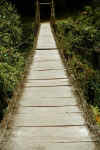
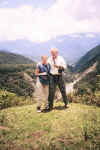
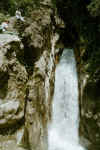 After properly stuffing ourselves, we head out for our first short hike, along the ridge of a hill, across a suspended bridge over a raging creek 100
plus feet below, then up, up, up on a windy, narrow trail.A half mile up or so we reach an abandoned shed, our
destination.The view is spectacular – a curling ribbon of creek has carved out a deep gorge, and a valley clothed in deep greens.The
mountain peaks are shrouded in smoky gray mists, hovering softly.
After properly stuffing ourselves, we head out for our first short hike, along the ridge of a hill, across a suspended bridge over a raging creek 100
plus feet below, then up, up, up on a windy, narrow trail.A half mile up or so we reach an abandoned shed, our
destination.The view is spectacular – a curling ribbon of creek has carved out a deep gorge, and a valley clothed in deep greens.The
mountain peaks are shrouded in smoky gray mists, hovering softly.
After a short stay there, we descend all the way down to the river, 1000 or more feet below, past a deafening waterfall, past a narrow rock formation called Devil’s Eye, and finally into the river bottom.It is rocky, the water clear and refreshingly cool.It begs us to dangle our feet in its chilly rush and we stay and relax for awhile before returning to the trufi.
And then our return to Cochabamba, back thru the misty, shrouded mountains, the patchwork farms like jigsaw puzzles covering the steep hillsides.Winding, crawling up the mountain roads, then finally out into the sunny dry valley leading into Cochabamba.
It’s nearly 5:00 by now, and we drop off our hiking companions, one by one in various neighborhoods of Cochabamba, then continue on to Vinto and the Casa de Retiros.It’s good to be back.
October 22 – 24, 2001
I feel almost guilty having such a long, wonderful weekend, when there is so much work at the Hogar.When we arrive early the next morning, we see that Felix and Moises have finished the center inside wall.The bricks now rise in a 15’ peak, hugging the steel beams on the roof.This week we will tear down the rest of the outside corrugated fiberglass walls and replace them with a concrete footer and brick walls.
 Parts of this outside wall are double bricks wide, and I find these walls much more
difficult to do and the work so much slower.My confidence from the past week begins to erode when I have to take the mezcla
and brick out to start all over again - sometimes 2 or 3 times before the brick finally sits at the right angle and level.When Felix comes over to
inspect and says “un poco mas”, I sigh deeply and begin repositioning the brick again.And when his inspection results in “esta bien”,
I smile with relief, and begin on the next brick.
Parts of this outside wall are double bricks wide, and I find these walls much more
difficult to do and the work so much slower.My confidence from the past week begins to erode when I have to take the mezcla
and brick out to start all over again - sometimes 2 or 3 times before the brick finally sits at the right angle and level.When Felix comes over to
inspect and says “un poco mas”, I sigh deeply and begin repositioning the brick again.And when his inspection results in “esta bien”,
I smile with relief, and begin on the next brick.
Diego, Ernesto and Lesa work with us several afternoons, as do some of the boys from the Hogar.Our goal is to finish all the outside walls, and we’re determined to reach or exceed this goal.Although the roof above us will eventually be replaced with a sturdier one, it will do for now.So if we can just finish the walls, this space will be usable when the rainy season begins in a month or so.
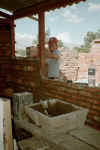 It is hotter this week, and we’re in the shade less often, so the sun saps our energy a bit more.Jean Carla has
told us that past groups have flagged a bit in the second week, and I’m personally determined to prove my energy level equal to or greater than the week
before.The nature of the work helps.It amazes me that I can concentrate on the perfect mixture of mezcla
and the placement of each individual brick so intensely that I lose track of time.The camaraderie among our coworkers helps too.We tease and
joke, as best our different languages allow, and we all care a lot about doing a really good job.Moises teaches us Quechuan for “OK”.It takes me
several days to get it right, but it sounds like “ko sah’ ree yah”.
It is hotter this week, and we’re in the shade less often, so the sun saps our energy a bit more.Jean Carla has
told us that past groups have flagged a bit in the second week, and I’m personally determined to prove my energy level equal to or greater than the week
before.The nature of the work helps.It amazes me that I can concentrate on the perfect mixture of mezcla
and the placement of each individual brick so intensely that I lose track of time.The camaraderie among our coworkers helps too.We tease and
joke, as best our different languages allow, and we all care a lot about doing a really good job.Moises teaches us Quechuan for “OK”.It takes me
several days to get it right, but it sounds like “ko sah’ ree yah”.
One afternoon after leaving the Hogar, we take the trufi to Sipe Sipe to visit a religious/historical site in the center of the small town – a spring with mysterious healing powers.Then we continue through the brown, dusty streets of Sipe Sipe, with its matching adobe buildings – crumbling and tired – up into the hills, past the Inca trail, winding our way up a mountain towards the ancient Inca city of Incarraqay.The view here is spectacular.In the fading evening light the last bits of valley are highlighted, the cradle of mountains showing off every ridge and peak in the creeping shadows.The land stretches forever.
It is easy to conjure up the Incas who once belonged to these mountains.Raul tells us a legend that when the Spaniards were on their way to conquer the Incas, the Incas took many large vases and jars, filled them with gold, and buried them in these mountains.Today, if you come looking for the gold with a good heart and without greed, you will find it; but if greed is your motive, you will not only fail to find anything, you will become crazy (loco) trying.
Back in Sipe Sipe, we visit a small bar where Jean Carla assures us the best guarapo in the area is made.Guarapo is a local wine.It probably would not grace the menus of the finer restaurants in the U. S., but for mezcla-covered gringos who’ve just descended from the mountains communing with the Incas, it’s pretty tasty.Sitting around a table, Jean Carla, Diego, Ernesto and Lesa teach Jim and Marvin and me a crazy dice game called alalay.I’m not sure I ever understood the rules, except that there are lots of things you do that require you to take another drink of guarapo.We linger long after dark, playing alalay, teasing and laughing with each other, not wanting this day to end.
 We’ve met our goals - the walls are finally finished.Jean Carla declares a celebration day with the children.We arrive at the Hogar a little
later than usual, and find the children dressed in their best clothes.Some of the older children have folkloric “costumes” – the girls in colorful
dresses of oranges, reds and yellows, the boys in dark pants with white shirts and mustaches painted on their faces.They
have prepared some dances for us – a cumbia, a Bolivian “fighting” song, and several other native dances.
We’ve met our goals - the walls are finally finished.Jean Carla declares a celebration day with the children.We arrive at the Hogar a little
later than usual, and find the children dressed in their best clothes.Some of the older children have folkloric “costumes” – the girls in colorful
dresses of oranges, reds and yellows, the boys in dark pants with white shirts and mustaches painted on their faces.They
have prepared some dances for us – a cumbia, a Bolivian “fighting” song, and several other native dances.

 In return, Marvin and I perform a country western dance, then the two-step – both to Bolivian music.After a couple
times around the floor with the two-step, I take Moises as my partner and Marvin takes Jean Carla.Later, I also
show Felix the two-step.Afterwards, Moises teaches me the cumbia, all the children join in, and we hold hands while dancing around the room.
In return, Marvin and I perform a country western dance, then the two-step – both to Bolivian music.After a couple
times around the floor with the two-step, I take Moises as my partner and Marvin takes Jean Carla.Later, I also
show Felix the two-step.Afterwards, Moises teaches me the cumbia, all the children join in, and we hold hands while dancing around the room.

 Later, we play a rousing game of futbol (soccer); then Jim takes individual Polaroid pictures of each child.The older ones are clearly pleased
and proud to be holding pictures of themselves, but the little ones, the 2 or 3 or even 4 year olds, have no idea
whose photo they are clutching in their tiny hands.Jean Carla reminds us that many of these children may never have seen a
mirror, thus they might not have any idea what they look like!It seems an incredible thought.
Later, we play a rousing game of futbol (soccer); then Jim takes individual Polaroid pictures of each child.The older ones are clearly pleased
and proud to be holding pictures of themselves, but the little ones, the 2 or 3 or even 4 year olds, have no idea
whose photo they are clutching in their tiny hands.Jean Carla reminds us that many of these children may never have seen a
mirror, thus they might not have any idea what they look like!It seems an incredible thought.

 We gather for a group photo in front of our brand new brick walls.A quiet 3 year old named Shirley hangs back.She had sat silently, without expression
all during the dancing and earlier photo sessions, and clung to her personal photo without a trace of
recognition. Now, I scoop her up and carry her toward the group photo, surprised at her unyielding and dead weight.My
15-month old granddaughter wraps her wiggly legs and arms around my body, snuggling in for the ride, but Shirley hangs like a heavy broom in my arms.
We gather for a group photo in front of our brand new brick walls.A quiet 3 year old named Shirley hangs back.She had sat silently, without expression
all during the dancing and earlier photo sessions, and clung to her personal photo without a trace of
recognition. Now, I scoop her up and carry her toward the group photo, surprised at her unyielding and dead weight.My
15-month old granddaughter wraps her wiggly legs and arms around my body, snuggling in for the ride, but Shirley hangs like a heavy broom in my arms.
Then, all 36 kids, 3 nuns, Felix and Moises, Jim and Jean Carla and Marvin and I all climb into one of two vehicles – the trufi or a truck driven by Santiago, the orphanage’s architect.I sit in the back of the truck, the only adult among 15 or so children.Shirley is standing, lost, in the middle of the truck, so I pull her unyielding body toward me and settle her in the cradle of my crossed legs.She says nothing but sits quietly.Then the truck heads off toward the Casa de Retiros.The older children beg me to sing, so I sing “She’ll be Coming ‘Round the Mountain” in English, then they respond with a religious song in Spanish.Then I sing another in English, and they in Spanish.
At the Casa de Retiros, we tumble out of the truck and into the dining room, where a luncheon feast is waiting.The kids are clearly excited, but on their very best behavior.There is no running or jockeying for tables, no pushing or shoving.They move in a swift, but orderly manner, and sit four to a table.The nuns split up to sit at tables where the littlest children are.
When everyone is settled, we bring out generous bowls of vegetable soup.The children’s eyes are bright with delight.There is no dining table at the orphanage, no sets of china and silverware, sometimes not even much food.The nuns still beg for food from various local sources, and don’t always have enough.But this is an endless feast – after the rich soup and bread, there are plates of fried meat with vegetables, and diced fruit for dessert.The kids gorge themselves, as though is the only meal of their short little lives.Among the intensely serious eating, there is happy chatter and food-streaked smiles.
But it is Shirley who breaks my heart.After her stoic silence and the body language of a stone, Shirley comes alive.Perched on her knees on the chair so she can reach the table top, her eyes now bright with excitement, she chatters away for the first time.Each time I near her table to see if plates need to be cleared, she turns and announces her table’s progress – “estamos comiendo” (we’re eating) she assures me the first several times.“Estamos terminando” (we’re finishing) she declares confidently after several rounds.And “esta bolsa es para carne” (this bag is for the meat) she proclaims proudly toward the end of the meal, as Jean Carla gives each table plastic bags to carry the leftover food back to the orphanage.
The child who never talked, never even reacted, has awakened.The difference is startling – the drab, lifeless statue has become a whir of motion, her head swiveling around to watch the other children, and those of us serving.Her eyes are now bright and shiny with interest, and there is playfulness in her body motions.The little person inside is showing.
Thelast tidbits of food are gone, and we herd the children to the trufi and Santiago’s truck for the trip back to the orphanage.It is time to wish everyone goodbye – Felix, Moises, the nuns and the precious children.There are hugs and thanks and hearty good wishes, and suddenly the vehicles are slowly inching away, their windows plastered with happy faces and greasy waving hands.Jean Carla, Jim and Marvin and I turn slowly to head for our rooms at the Casa and pack.
October 25 – 26, 2001
It is time for the slow song of goodbye.Raul returns with the trufi to take us to Planeta de Luz, an ecological

 resort
just outside Quillacollo.It is an amazing place - truly born of the 60’s flower-child era, acres of lush,
flowered grounds with llamas and peacocks roaming.There are unique round cabins, one with a star gazing patio on the roof,
and there is a swimming pool, sauna and massage rooms. Marvin treats himself to a massage, and the others to a sauna.On
the shaded patio by the pool, we have delicious empanadas of a spicy cheese, and fresh pineapple juice. Late in the afternoon, we head
back to Cochabamba and spend the night in our rooms at the Hostal Jardin.
resort
just outside Quillacollo.It is an amazing place - truly born of the 60’s flower-child era, acres of lush,
flowered grounds with llamas and peacocks roaming.There are unique round cabins, one with a star gazing patio on the roof,
and there is a swimming pool, sauna and massage rooms. Marvin treats himself to a massage, and the others to a sauna.On
the shaded patio by the pool, we have delicious empanadas of a spicy cheese, and fresh pineapple juice. Late in the afternoon, we head
back to Cochabamba and spend the night in our rooms at the Hostal Jardin.
 It is the day before we leave Bolivia, and we have a free day in Cochabamba.After breakfast, we meet with Jean Carla in the patio of the Hostal
to see the photo albums of previous Amizade volunteer groups and the work at the orphanage.It is heartwarming
to see the amount of progress in just over a year.And Jean Carla’s enthusiasm is so contagious, her love for the children
so palpable.I’m simultaneously feeling good about what we accomplished, and musing on the future of those children’s precious lives.
It is the day before we leave Bolivia, and we have a free day in Cochabamba.After breakfast, we meet with Jean Carla in the patio of the Hostal
to see the photo albums of previous Amizade volunteer groups and the work at the orphanage.It is heartwarming
to see the amount of progress in just over a year.And Jean Carla’s enthusiasm is so contagious, her love for the children
so palpable.I’m simultaneously feeling good about what we accomplished, and musing on the future of those children’s precious lives.
We mosey down to the 14 de Septiembre plaza to find souvenirs – books, maps of Bolivia, cookbooks and CDs of folkloric music.We wander through an arts and crafts market and pick up a few presents.And we have a farewell luncheon at a posh restaurant with Lesa, Diego and Ernesto – toasting the Hogar, Amizade and each other’s futures.

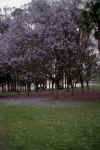 The afternoon offers more glorious Cochabamban sunshine, and the jacarandas have
outdone themselves in their emerging splendor during the last week.It is Friday afternoon, and the streets are alive and bustling with
people. We stop at an internet café for final messages, and treat ourselves to beer and jugo de frutilla (strawberry juice) at a busy restaurant.
The afternoon offers more glorious Cochabamban sunshine, and the jacarandas have
outdone themselves in their emerging splendor during the last week.It is Friday afternoon, and the streets are alive and bustling with
people. We stop at an internet café for final messages, and treat ourselves to beer and jugo de frutilla (strawberry juice) at a busy restaurant.
During the evening, Jim and I attend a concert in the Teatro Atra by Bonanza – a group of seven Bolivians who perform romantic folkloric songs. The music is enchanting.The lead singer has a rich and hearty voice, and he fills the theater with his joy for singing.The guitars, combinations of flutes and percussion are variously soulful, haunting, lively, and resounding.
Listening in the dark to the music, my thoughts wander back to the faces of the children and the memories of Shirley’s bright, vivid eyes.What could I do to make a bigger difference here?There has to be more. Tomorrow we’ll board a plane, and in no time at all, be a zillion miles away from here.It would be so easy to let this experience gradually fade into cherished and happy memories.But Cochabamba is a city I could live in for awhile, a place I could stay if there were a longer term project at the Hogar. And the children need so much more. I close my eyes and let the music melt down inside me, holding and savoring its melody so I can remember until I return.